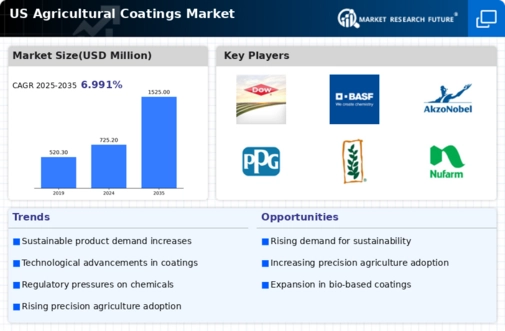Growing Awareness of Crop Quality
The agricultural coatings market is influenced by the rising awareness of crop quality among consumers and producers alike. As consumers demand higher quality produce, farmers are compelled to adopt coatings that enhance the appearance and shelf life of their crops. This trend is particularly evident in the fresh produce sector, where coatings that prevent spoilage and maintain freshness are increasingly sought after. Market analysts project that the demand for quality-enhancing coatings will contribute to a growth rate of approximately 5% in the agricultural coatings market by 2025. Consequently, manufacturers are focusing on developing coatings that not only protect crops but also improve their marketability, thereby addressing the evolving expectations of the agricultural coatings market.
Rising Demand for Crop Protection
The market experiences a notable increase in demand for crop protection solutions. Farmers are increasingly seeking coatings that enhance the durability and effectiveness of pesticides and herbicides. This trend is driven by the need to maximize crop yields while minimizing environmental impact. In 2025, the market for agricultural coatings is projected to reach approximately $1.5 billion, reflecting a growth rate of around 6% annually. The emphasis on sustainable farming practices further propels the demand for innovative coatings that offer both protection and environmental benefits. As a result, manufacturers are focusing on developing coatings that not only protect crops but also contribute to soil health and biodiversity, thereby aligning with the evolving needs of the agricultural coatings market.
Regulatory Compliance and Standards
Regulatory frameworks significantly impact the agricultural coatings market, as compliance with safety and environmental standards becomes increasingly stringent. In the US, agencies such as the Environmental Protection Agency (EPA) enforce regulations that govern the use of agricultural chemicals and coatings. This regulatory landscape compels manufacturers to innovate and develop coatings that meet these standards while ensuring efficacy. The market is expected to grow as companies invest in compliance-driven research, with projections indicating a potential increase in market size by 4% annually. Furthermore, adherence to regulations not only enhances product credibility but also fosters consumer trust, which is vital for the agricultural coatings market.
Advancements in Coating Technologies
Technological innovations play a crucial role in shaping the agricultural coatings market. The introduction of advanced formulations and application techniques enhances the performance of coatings, making them more effective in protecting crops. For instance, the development of nano-coatings has shown promise in improving the adhesion and longevity of agricultural coatings. These advancements are expected to drive market growth, with estimates suggesting a compound annual growth rate (CAGR) of 5% through 2025. Additionally, the integration of smart technologies, such as sensors and IoT, into coating applications is likely to optimize usage and reduce waste. This technological evolution not only improves the efficiency of agricultural practices but also aligns with the sustainability goals of the agricultural coatings market.
Increased Focus on Sustainable Practices
The market is witnessing a shift towards sustainable practices, driven by consumer preferences and regulatory pressures. Farmers are increasingly adopting eco-friendly coatings that reduce chemical runoff and promote soil health. This trend is reflected in the growing market for bio-based coatings, which are derived from renewable resources. In 2025, it is anticipated that sustainable coatings will account for over 30% of the total agricultural coatings market. This shift not only addresses environmental concerns but also enhances the market's appeal to environmentally conscious consumers. As a result, manufacturers are investing in research and development to create coatings that meet sustainability criteria while maintaining high performance, thereby influencing the overall dynamics of the agricultural coatings market.






















Leave a Comment